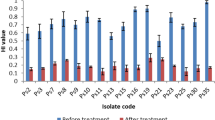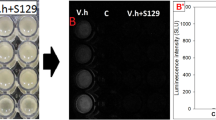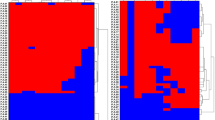Abstract
We have shown that the quorum-sensing signals acylhomoserine lactones, autoinducer-2 (AI-2) and indole influence the biofilm formation of Escherichia coli. Here, we investigate how the environment, that is, temperature, affects indole and AI-2 signaling in E. coli. We show in biofilms that indole addition leads to more extensive differential gene expression at 30 °C (186 genes) than at 37 °C (59 genes), that indole reduces biofilm formation (without affecting growth) more significantly at 25 and 30 °C than at 37 °C and that the effect is associated with the quorum-sensing protein SdiA. The addition of indole at 30 °C compared to 37 °C most significantly repressed genes involved in uridine monophosphate (UMP) biosynthesis (carAB, pyrLBI, pyrC, pyrD, pyrF and upp) and uracil transport (uraA). These uracil-related genes are also repressed at 30 °C by SdiA, which confirms SdiA is involved in indole signaling. Also, compared to 37 °C, indole more significantly decreased flagella-related qseB, flhD and fliA promoter activity, enhanced antibiotic resistance and inhibited cell division at 30 °C. In contrast to indole and SdiA, the addition of (S)-4,5-dihydroxy-2,3-pentanedione (the AI-2 precursor) leads to more extensive differential gene expression at 37 °C (63 genes) than at 30 °C (11 genes), and, rather than repressing UMP synthesis genes, AI-2 induces them at 37 °C (but not at 30 °C). Also, the addition of AI-2 induces the transcription of virulence genes in enterohemorrhagic E. coli O157:H7 at 37 °C but not at 30 °C. Hence, cell signals cause diverse responses at different temperatures, and indole- and AI-2-based signaling are intertwined.
Similar content being viewed by others
Log in or create a free account to read this content
Gain free access to this article, as well as selected content from this journal and more on nature.com
or
References
Ahmer BM . (2004). Cell-to-cell signalling in Escherichia coli and Salmonella enterica. Mol Microbiol 52: 933–945.
Amábile-Cuevas CF, Demple B . (1991). Molecular characterization of the soxRS genes of Escherichia coli: two genes control a superoxide stress regulon. Nucleic Acids Res 19: 4479–4484.
Anyanful A, Dolan-Livengood JM, Lewis T, Sheth S, DeZalia MN, Sherman MA et al. (2005). Paralysis and killing of Caenorhabditis elegans by enteropathogenic Escherichia coli requires the bacterial tryptophanase gene. Mol Microbiol 57: 988–1007.
Baba T, Ara T, Hasegawa M, Takai Y, Okumura Y, Baba M et al. (2006). Construction of Escherichia coli K-12 in-frame, single-gene knockout mutants: the Keio collection. Mol Syst Biol 2: 2006 0008.
Bansal T, Englert D, Lee J, Hegde M, Wood TK, Jayaraman A . (2007). Differential effects of epinephrine, norepinephrine, and indole on Escherichia coli O157:H7 chemotaxis, colonization, and gene expression. Infect Immun 75: 4597–4607.
Bösl M, Kersten H . (1991). A novel RNA product of the tyrT operon of Escherichia coli. Nucleic Acids Res 19: 5863–5870.
Chant EL, Summers DK . (2007). Indole signalling contributes to the stable maintenance of Escherichia coli multicopy plasmids. Mol Microbiol 63: 35–43.
Cherepanov PP, Wackernagel W . (1995). Gene disruption in Escherichia coli: TcR and KmR cassettes with the option of Flp-catalyzed excision of the antibiotic-resistance determinant. Gene 158: 9–14.
Davies DG, Parsek MR, Pearson JP, Iglewski BH, Costerton JW, Greenberg EP . (1998). The involvement of cell-to-cell signals in the development of a bacterial biofilm. Science 280: 295–298.
De Keersmaecker SC, Varszegi C, van Boxel N, Habel LW, Metzger K, Daniels R et al. (2005). Chemical synthesis of (S)-4,5-dihydroxy-2,3-pentanedione, a bacterial signal molecule precursor, and validation of its activity in Salmonella typhimurium. J Biol Chem 280: 19563–19568.
Di Martino P, Fursy R, Bret L, Sundararaju B, Phillips RS . (2003). Indole can act as an extracellular signal to regulate biofilm formation of Escherichia coli and other indole-producing bacteria. Can J Microbiol 49: 443–449.
Domka J, Lee J, Wood TK . (2006). YliH (BssR) and YceP (BssS) regulate Escherichia coli K-12 biofilm formation by influencing cell signaling. Appl Environ Microbiol 72: 2449–2459.
Edgar R, Domrachev M, Lash AE . (2002). Gene Expression Omnibus: NCBI gene expression and hybridization array data repository. Nucleic Acids Res 30: 207–210.
Gonnet P, Rudd KE, Lisacek F . (2004). Fine-tuning the prediction of sequences cleaved by signal peptidase II: a curated set of proven and predicted lipoproteins of Escherichia coli K-12. Proteomics 4: 1597–1613.
González Barrios AF, Zuo R, Hashimoto Y, Yang L, Bentley WE, Wood TK . (2006). Autoinducer 2 controls biofilm formation in Escherichia coli through a novel motility quorum-sensing regulator (MqsR, B3022). J Bacteriol 188: 305–316.
Hall-Stoodley L, Costerton JW, Stoodley P . (2004). Bacterial biofilms: from the natural environment to infectious diseases. Nat Rev Microbiol 2: 95–108.
Herzberg M, Kaye IK, Peti W, Wood TK . (2006). YdgG (TqsA) controls biofilm formation in Escherichia coli K-12 through autoinducer 2 transport. J Bacteriol 188: 587–598.
Hirakawa H, Inazumi Y, Masaki T, Hirata T, Yamaguchi A . (2005). Indole induces the expression of multidrug exporter genes in Escherichia coli. Mol Microbiol 55: 1113–1126.
Hobman JL, Patel MD, Hidalgo-Arroyo GA, Cariss SJ, Avison MB, Penn CW et al. (2007). Comparative genomic hybridization detects secondary chromosomal deletions in Escherichia coli K-12 MG1655 mutants and highlights instability in the flhDC region. J Bacteriol 189: 8786–8792.
Juncker AS, Willenbrock H, Von Heijne G, Brunak S, Nielsen H, Krogh A . (2003). Prediction of lipoprotein signal peptides in Gram-negative bacteria. Protein Sci 12: 1652–1662.
Kendall MM, Rasko DA, Sperandio V . (2007). Global effects of the cell-to-cell signaling molecules autoinducer-2, autoinducer-3, and epinephrine in a luxS mutant of enterohemorrhagic Escherichia coli. Infect Immun 75: 4875–4884.
Lee J, Bansal T, Jayaraman A, Bentley WE, Wood TK . (2007a). Enterohemorrhagic Escherichia coli biofilms are inhibited by 7-hydroxyindole and stimulated by isatin. Appl Environ Microbiol 73: 4100–4109.
Lee J, Jayaraman A, Wood TK . (2007b). Indole is an inter-species biofilm signal mediated by SdiA. BMC Microbiol 7: 42.
Lee J, Page R, García-Contreras R, Palermino JM, Zhang XS, Doshi O et al. (2007c). Structure and function of the Escherichia coli protein YmgB: a protein critical for biofilm formation and acid-resistance. J Mol Biol 373: 11–26.
Michael B, Smith JN, Swift S, Heffron F, Ahmer BM . (2001). SdiA of Salmonella enterica is a LuxR homolog that detects mixed microbial communities. J Bacteriol 183: 5733–5742.
Moons P, Van Houdt R, Aertsen A, Vanoirbeek K, Engelborghs Y, Michiels CW . (2006). Role of quorum sensing and antimicrobial component production by Serratia plymuthica in formation of biofilms, including mixed biofilms with Escherichia coli. Appl Environ Microbiol 72: 7294–7300.
Morrison RB, McCapra J . (1961). Flagellar changes in Escherichia coli induced by temperature of the environment. Nature 192: 774–776.
Newton WA, Snell EE . (1965). Formation and interrelationships of tryptophanase and tryptophan synthetases in Escherichia coli. J Bacteriol 89: 355–364.
Potera C . (1999). Forging a link between biofilms and disease. Science 283: 1837–1839.
Poulsen LK, Refn A, Molin S, Andersson P . (1991). The gef gene from Escherichia coli is regulated at the level of translation. Mol Microbiol 5: 1639–1648.
Pratt LA, Kolter R . (1998). Genetic analysis of Escherichia coli biofilm formation: roles of flagella, motility, chemotaxis and type I pili. Mol Microbiol 30: 285–293.
Rahman M, Simm R, Kader A, Basseres E, Römling U, Mollby R . (2007). The role of c-di-GMP signaling in an Aeromonas veroniibiovar sobria strain. FEMS Microbiol Lett 273: 172–179.
Rahmati S, Yang S, Davidson AL, Zechiedrich EL . (2002). Control of the AcrAB multidrug efflux pump by quorum-sensing regulator SdiA. Mol Microbiol 43: 677–685.
Ren D, Bedzyk LA, Thomas SM, Ye RW, Wood TK . (2004a). Gene expression in Escherichia coli biofilms. Appl Microbiol Biotechnol 64: 515–524.
Ren D, Bedzyk LA, Ye RW, Thomas SM, Wood TK . (2004b). Differential gene expression shows natural brominated furanones interfere with the autoinducer-2 bacterial signaling system of Escherichia coli. Biotechnol Bioeng 88: 630–642.
Ryjenkov DA, Simm R, Romling U, Gomelsky M . (2006). The PilZ domain is a receptor for the second messenger c-di-GMP: the PilZ domain protein YcgR controls motility in enterobacteria. J Biol Chem 281: 30310–30314.
Sambrook J, Fritsch EF, Maniatis T . (1989). Molecular Cloning: A Laboratory Manual. Cold Spring Harbor Laboratory Press: Cold Spring Harbor, NY.
Sperandio V, Torres AG, Girón JA, Kaper JB . (2001). Quorum sensing is a global regulatory mechanism in enterohemorrhagic Escherichia coli O157:H7. J Bacteriol 183: 5187–5197.
Sperandio V, Torres AG, Kaper JB . (2002). Quorum sensing Escherichia coli regulators B and C (QseBC): a novel two-component regulatory system involved in the regulation of flagella and motility by quorum sensing in E. coli. Mol Microbiol 43: 809–821.
Stanley NR, Lazazzera BA . (2004). Environmental signals and regulatory pathways that influence biofilm formation. Mol Microbiol 52: 917–924.
Surette MG, Bassler BL . (1998). Quorum sensing in Escherichia coli and Salmonella typhimurium. Proc Natl Acad Sci USA 95: 7046–7050.
Suzuki K, Wang X, Weilbacher T, Pernestig AK, Melefors O, Georgellis D et al. (2002). Regulatory circuitry of the CsrA/CsrB and BarA/UvrY systems of Escherichia coli. J Bacteriol 184: 5130–5140.
Tao Y, Fishman A, Bentley WE, Wood TK . (2004). Altering toluene 4-monooxygenase by active-site engineering for the synthesis of 3-methoxycatechol, methoxyhydroquinone, and methylhydroquinone. J Bacteriol 186: 4705–4713.
Van Houdt R, Aertsen A, Moons P, Vanoirbeek K, Michiels CW . (2006). N-acyl-L-homoserine lactone signal interception by Escherichia coli. FEMS Microbiol Lett 256: 83–89.
Wang D, Ding X, Rather PN . (2001). Indole can act as an extracellular signal in Escherichia coli. J Bacteriol 183: 4210–4216.
Wang L, Li J, March JC, Valdes JJ, Bentley WE . (2005). luxS-dependent gene regulation in Escherichia coli K-12 revealed by genomic expression profiling. J Bacteriol 187: 8350–8360.
Wang XD, de Boer PA, Rothfield LI . (1991). A factor that positively regulates cell division by activating transcription of the major cluster of essential cell division genes of Escherichia coli. EMBO J 10: 3363–3372.
Waters CM, Bassler BL . (2006). The Vibrio harveyi quorum-sensing system uses shared regulatory components to discriminate between multiple autoinducers. Genes Dev 20: 2754–2767.
Wei Y, Lee JM, Smulski DR, LaRossa RA . (2001). Global impact of sdiA amplification revealed by comprehensive gene expression profiling of Escherichia coli. J Bacteriol 183: 2265–2272.
White-Ziegler CA, Malhowski AJ, Young S . (2007). Human body temperature (37 °C) increases the expression of iron, carbohydrate, and amino acid utilization genes in Escherichia coli K-12. J Bacteriol 189: 5429–5440.
White-Ziegler CA, Um S, Pérez NM, Berns AL, Malhowski AJ, Young S . (2008). Low temperature (23 °C) increases expression of biofilm-, cold-shock- and RpoS-dependent genes in Escherichia coli K-12. Microbiology 154: 148–166.
Wood TK, González Barrios AF, Herzberg M, Lee J . (2006). Motility influences biofilm architecture in Escherichia coli. Appl Microbiol Biotechnol 72: 361–367.
Wood TK, Peretti SW . (1991). Effect of chemically-induced, cloned-gene expression on protein synthesis in E. coli. Biotechnol Bioengr 38: 397–412.
Xavier KB, Bassler BL . (2005). Regulation of uptake and processing of the quorum-sensing autoinducer AI-2 in Escherichia coli. J Bacteriol 187: 238–248.
Yao Y, Martinez-Yamout MA, Dickerson TJ, Brogan AP, Wright PE, Dyson HJ . (2006). Structure of the Escherichia coli quorum sensing protein SdiA: activation of the folding switch by acyl homoserine lactones. J Mol Biol 355: 262–273.
Zhang XS, García-Contreras R, Wood TK . (2007). YcfR (BhsA) influences Escherichia coli biofilm formation through stress response and surface hydrophobicity. J Bacteriol 189: 3051–3062.
Acknowledgements
This research was supported by the NIH (5RO1EB003872-05) and ARO (W911NF-06-1-0408). We thank the National Institute of Genetics for providing the Keio clones and Dr V Sperandio for providing E. coli O157:H7 luxS and plasmids pVS159, pVS182 and pVS183.
Author information
Authors and Affiliations
Corresponding author
Additional information
Supplementary Information accompanies the paper on The ISME Journal website (http://www.nature.com/ismej)
Supplementary information
Rights and permissions
About this article
Cite this article
Lee, J., Zhang, XS., Hegde, M. et al. Indole cell signaling occurs primarily at low temperatures in Escherichia coli. ISME J 2, 1007–1023 (2008). https://doi.org/10.1038/ismej.2008.54
Received:
Revised:
Accepted:
Published:
Issue date:
DOI: https://doi.org/10.1038/ismej.2008.54
Keywords
This article is cited by
-
Strategies for Biofilm Inhibition and Virulence Attenuation of Foodborne Pathogen-Escherichia coli O157:H7
Current Microbiology (2017)
-
The inner membrane protein YhiM is necessary for Escherichia coli growth at high temperatures and low osmolarity
Archives of Microbiology (2017)
-
Isolation of Indole Utilizing Bacteria Arthrobacter sp. and Alcaligenes sp. From Livestock Waste
Indian Journal of Microbiology (2016)
-
Application of the Bi-CoPaM Method to Five Escherichia Coli Datasets Generated under Various Biological Conditions
Journal of Signal Processing Systems (2015)
-
A predictor for predicting Escherichia colitranscriptome and the effects of gene perturbations
BMC Bioinformatics (2014)



